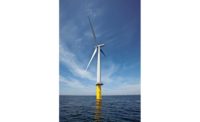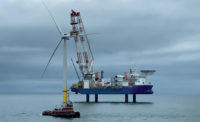In a big boost to the emerging U.S. offshore wind market, Danish wind developer Orsted announced on Sept. 19 the first worldwide commercial deployment of GE Renewables' offshore wind mega-turbine—the 12-MW Haliade-X now being tested in Europe—at its proposed wind farms off the coasts of Maryland and New Jersey.
Compared to New York City's Chrysler Building in height, about 853 ft, the new turbine has the largest capacity on the market and a rotor diameter of 220 meters.
Subject to a final contract and project approvals, the turbines will be installed at the 120-MW Skipjack wind farm set to be built off the coast of Ocean City, Md. and at New Jersey’s 1,100-MW Ocean wind farm planned off Atlantic City—the state’s first project and currently the largest offshore capacity award in the U.S. Together these form Orsted’s Mid-Atlantic Cluster.
The Haliade-X represents about a $400-million R&D investment by GE.
Swedish offshore wind developer Vattenfall also has indicated plans to deploy the Haliade-X in its North and Baltic Sea projects, part of an estimated global offshore wind market estimated by forecasters to grow to 1,000 GW by 2050,
"By dramatically improving efficiencies for installation services, balance of plant components and operations and maintenance over an offshore wind farm’s lifetime, the addition of 12-MW turbines to our projects positions us to further improve the reliability of energy produced by green, offshore wind in the U.S.,” said Orsted North American President Thomas Brostrom. “Today’s announcement brings us one step closer to a fully-fledged American offshore wind industry.”
Also propelling the U.S. market was the Sept. 19 announcement that Dominion Energy will build more than 2,600 MW of offshore wind in three phases, starting power generation in 2024 and continuing though 2026 with more than 220 turbines in a 112,800-acre leased area off the Virginia coast at Virginia Beach.
It would become the nation's largest development when completed, at an estimated $7.8 billion project cost.
The utility filed an application with the grid operator to interconnect the project to the transmission grid. Orsted had previously developed Dominion Energy's 12-MW pilot offshore wind project offshore that is set to be deployed in 2020.
Through a recent acquisition, Orsted owns the only operating offshore wind farm built in U.S. waters, the 30-MW Block Island project off the coast of Rhode Island, which pioneered the use of GE’s 6-MW Haliade turbine.
Orsted also has been awarded the rights to build offshore wind farms in New York and Connecticut.
Power Pricing
New Jersey plans to build 3,500 MW offshore by 2030. The next solicitation will be released next year and a third in 2022. Construction of the first project, estimated at $1.6 billion, should be completed in 2024.
The award and the state’s procurement schedule are considered to be critical to give manufacturers the confidence needed to make the investments require to set up a local supply chain and manufacturing, says Liz Burdock, CEO and president, Business Network for Offshore Wind.
Orsted's Ocean Wind project also won approval from New Jersey regulators on Sept. 16 for capacity interconnection rights at the former Oyster Creek nuclear power plant in Lacey Township, which advocates say could reduce costs to connect to the regional transmission system, although transmission costs remain undetermined, according to online publication NJ Spotlight.
Other industry participants cite the low price for the New Jersey project's generated power as a critical driver. Orsted offered a first-year price of $98.10/MWh with the actual cost paid by ratepayers estimated to be $46.46/MWh after energy and capacity revenues are refunded to ratepayers. The increase to residential ratepayers is estimated at $1.46.
The award brings to 2,000 MW Orsted’s offshore wind portfolio in the Northeast and mid-Atlantic U.S. regions to be completed between 2022 and 2024.
New Jersey said competition was robust, but it chose the Orsted project for its positive economic and environmental benefits. It had the most advanced environmental protections during construction and operation and offered the most detailed economic benefits that totaled $1.7 billion. The project also has a memorandum of understanding with a German manufacturer to spur construction of a monopole foundation fabrication plant in Paulsboro, N.J. and is expected to sign one with the South Jersey Building and Construction Trades Council to only hire union labor for construction.
Orsted has an agreement with the state’s largest utility owner, PSEG, to provide energy management services.
Still unclear is whether and how the state and federal regulators will approve a proposal by Anbaric Development Partners for a right-of-way to develop an offshore grid system to serve multiple regional developers, using several offshore collector platforms, each connected to one or more high voltage subsea export cables to onshore points.
Orsted's Brostrom has publicly voiced opposition to that proposal.






Post a comment to this article
Report Abusive Comment